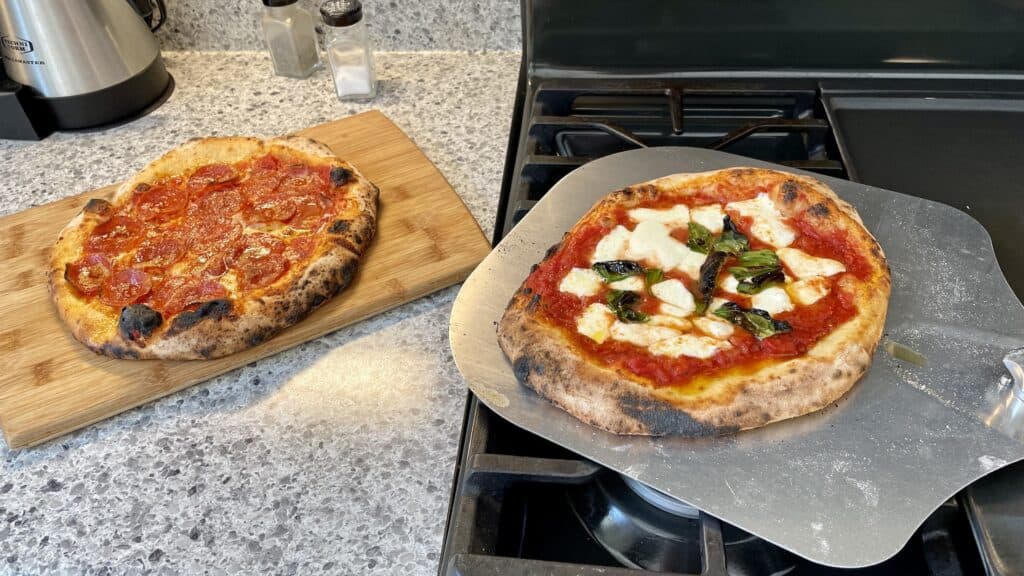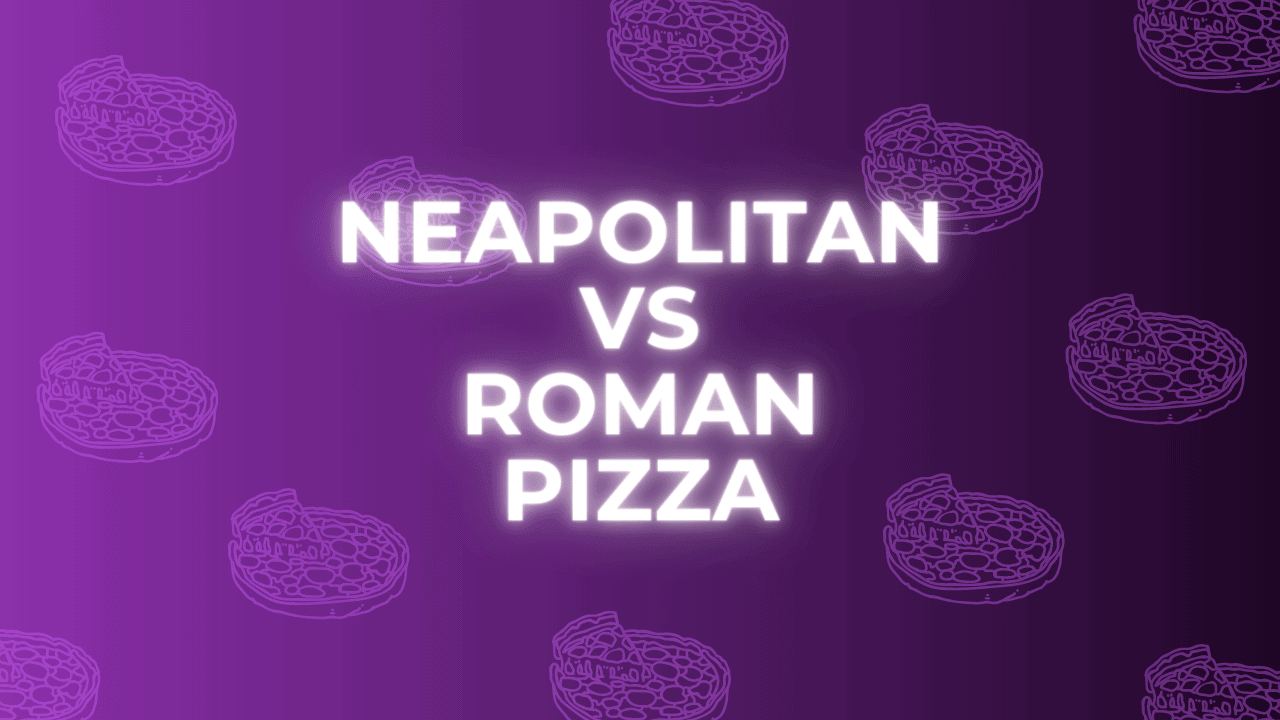If you’re jumping down the pizza rabbit hole…
You’ve probably discovered a TON of new pizza styles you previously didn’t know existed. And while that’s exciting, it’s also overwhelming. 🤯
Let’s look at Roman vs Neapolitan pizza.
Here is the key difference between Neapolitan and Roman Pizza (both found in Italy):
- Both styles have simple doughs that are made of soft flour (Tipo 00), yeast, water, and salt, but Roman-style pizza also contains oil.
- Neapolitan pizza is generally served as a whole pie (circle), while Roman pizza is often square (or rectangle), and served in rectangular slices.
- Neapolitan crust is thin towards the middle, and the outside is bubbly, soft, and slightly crunchy. Roman pizza crust is more like a cracker, thin and extra-crunchy.
I’ve had both of these pizzas (in Italy!), and I love them both equally!
So what other differences are there between these two titans of the pizza world?
Let’s dive in and see, shall we?
What is Neapolitan Pizza?

Neapolitan Pizza is a very simple pizza that originated in Naples. And with a Neapolitan pizza, you won’t find a ton of fancy toppings.
Margherita is probably the most well-known Neapolitan, and is has:
- Fresh mozzarella
- Fresh basil
- Olive oil
That’s it.
Of course, you have the dough. Then raw tomatoes which must be either San Marzano tomatoes or Pomodori Pelati tomatoes. (San Marzanos are WONDERFUL and the most popular. You can usually find those canned in your local grocery store)!
And unlike other pizzas with a Neapolitan pizza, there is typically more sauce than cheese. And because of this, it tends to make the middle of the pizza a little soggy (not necessarily in a bad way, though you might need to fold the pizza (or use a fork) to eat it).
You won’t find a Neapolitan pizza being sold by the slice. That’s why a traditional Neapolitan pizza is usually 10 or 14 inches in size. Great for one hungry person or perfect for sharing with a friend.
And you don’t have to wait long for your pizza. A Neapolitan pizza is cooked at a very high temperature. We’re talking 850 to 900 degrees Fahrenheit for no more than 90 seconds.
Neapolitan Fun Fact:
Did you know that a pizzeria can get certification for serving authentic Neapolitan pizzas?
Well, you can. The VPN (Associazione Verace Pizza Napoletana) was founded in Naples in 1884 and provides this certification.
There are several specific requirements (must use Tipo 00 flour, fresh brewer’s yeast, etc), and only a few hundred restaurants around the world including Italy that have VPN certification.
Variations Of Neapolitan Pizza
There are only 3 official variants of the Neapolitan pizza.
- Pizza Margherita – this style is topped with tomatoes, sliced mozzarella, basil, and extra virgin olive oil.
- Pizza Marinara – this style is topped with tomatoes, garlic, oregano, and extra virgin olive oil.
- Pizza Margherita extra – this style is topped with tomatoes, mozzarella from Campania, basil, and extra virgin olive oil.
See this post for more about Tipo 00 flour (the preferred for Neapolitan pizza).
What Is Traditional Roman Pizza?
The traditional Roman-style pizza, or “Pizza al taglio” (that means “pizza by the cut”) is cooked in a 500-degree (F) oven for 10 to 15 minutes.
This is a rectangular-shaped pizza that you’ll find displayed in bakeries in Rome topped with a variety of ingredients.
And when at a bakery you’re going to buy your pizza by weight. The baker will cut the size of pizza you want with scissors, hence the term “pizza by the cut” and then serve it to you in a paper bag.
You’ll also find this is the pizza that is typically sold by street venders in Rome.
Neapolitan vs Roman vs Sicilian Pizza: Which is better?
This comes down to personal preference. You could put all 3 pizzas on a table and each person will have their favorite.
Each piazza has its likable qualities:
- The Neapolitan is thin, with a charred bubbly crust, and is made with traditional ingredients.
- A Sicilian pizza has a thicker, softer crust, kind of like focaccia bread.
- And Roman, the peasant’s pizza. Simple toppings and the perfect snack food.
Related post: Detroit vs Chicago vs Sicilian Pizza: What’s the Difference?
While Neapolitan is easily the most popular here in America, these are all fantastic Italian pizzas!
Traditional Italian Pizza F.A.Q.s
What toppings go on a Roman pizza?
The early Roman pizza was a cheap peasant food and was topped with simple ingredients such as olive oil, cheese, and vegetables.
Today in Rome, the classic pizza is called the Capricciosa. It is topped with ham, mushrooms, olives, artichoke, an egg, and tomato.
What makes a Neapolitan pizza different?
Unlike other pizzas that can take 10 to 20 minutes to cook. A traditional Neapolitan pizza is cooked in a wood-burning oven that’s between 800 and 900 degrees and is cooked for no more than 90 seconds.
Because of this fast, high-heat baking, Neapolitan pizza has a unique crust that’s crispy yet chewy at the same time.
And a Neapolitan pizza usually features a sauce made from San Marzano tomatoes, and has only 2-3 toppings (and drizzled in olive oil)!
What is Roman-style pizza called?
Roman-style pizza is known as “Pizza al taglio” (pizza by the cut). Or “pizza Romana” in Italy. It has a cracker-like crunchy crust and is usually served in square or rectangular slices.
What’s the difference between Neapolitan and Sicilian pizza?
The main difference between a Neapolitan and Sicilian pizza is the crust. With a Neapolitan pizza, the crust is thinner and crispy. A Sicilian pizza crust is soft and thicker.
Along with the difference in the crusts, a Neapolitan pizza takes no more than 90 seconds to cook in a wood-burning oven that’s between 800 and 900 degrees.
A Sicilian pizza is cooked in an oven for 5 to 10 minutes at 500 degrees.
With a Sicilian pizza, you can use canned tomatoes. Whereas, with a Neapolitan pizza, you cannot. You must use San Marzano tomatoes.
You can also add additional toppings to a Sicilian pizza such as onions and anchovies. With a Neapolitan pizza, there are no more than 3 toppings.

